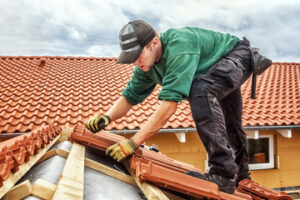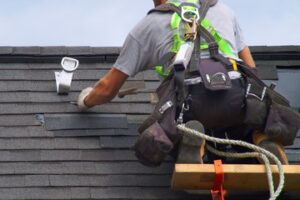Your roof is one of the most important components of your home, protecting it from the elements. Roofing is hard work that requires the right tools and knowledge to do correctly.
Before your roof gets installed, the crew will roll out underlayment, a felt-like material that protects against moisture intrusion. Then, they will install the first row of shingles, overlapping the starter strip.

There are a wide variety of roofing materials available, each with its own advantages and drawbacks. A professional roofing contractor can help homeowners select the right material for their project, taking into account factors such as cost, lifespan, aesthetics, and climate.
The most common roofing material is asphalt shingles, which come in a range of colors and styles. They are affordable, durable, and easy to install. However, they are not as resistant to fire and hail as some other types of roofing. They are also more susceptible to moss and mildew than other roofing materials.
Wood shakes and shingles are another popular choice for residential roofs. These natural-looking materials are made from split logs of cedar or redwood, and they add a rustic charm to older homes. While they are beautiful, they don’t last as long as other roofing materials, and they require regular treatments to protect against moisture absorption, mold, and mildew.
Other types of roofing materials include clay and concrete tiles, which add an architectural elegance to a home. These are expensive but long-lasting, and they are non-combustible and energy efficient. They work well with Mediterranean, Mission, and Southwestern-style homes.
Rolled roofing is another option for low-pitch roofs. It is usually black and rolls out like one large shingle, so it’s not as attractive as other roofing materials. However, it’s inexpensive and is easy to install, making it a good choice for those on a tight budget.
A flat roof requires a waterproof membrane to prevent water infiltration. It can be constructed from various materials, including tar and fiberglass. Some homeowners choose to use plastic or rubber roof liners, which are more environmentally friendly than other products.
A well-designed and maintained roof can add value to a home, increase its resale value, and lower energy costs. To ensure the longevity of a roof, homeowners should regularly inspect it for signs of wear and tear, and follow the recommended maintenance schedule. Depending on the type of roof, maintenance may involve cleaning, treating with a water-repellent coating, and applying ice dam barriers. Other common maintenance tasks include replacing broken or damaged shingles, repairing eaves and valleys, and installing flashing to prevent water intrusion at critical points such as chimneys, vents, skylights, and other protrusions.
Safety
Safety is a non-negotiable requirement in roofing, and the heightened risk of injuries and fatalities makes it imperative that rigorous training, proper gear, and strict adherence to work protocols are followed. This will not only protect workers and minimize risks, but it will also contribute to better workmanship and project outcomes.
A comprehensive roof installation project requires a variety of tools and equipment. These items may include ladders, scaffolding, power tools and more. Each must be carefully inspected, maintained and used in accordance with manufacturer guidelines. It is also important to have a thorough plan for any potential emergencies that could arise on the job site, including clear communication with team members, emergency contacts, and a designated escape route.
Roofing contractors must make sure that each worker is equipped with the proper personal protective equipment (PPE), including hard hats, eye protection, non-slip footwear, and harnesses for working at heights. Additionally, each worker must be provided with a tool belt or bucket to keep tools and materials organized and away from walkways to prevent tripping and falling hazards.
Any open rooftops must be covered to protect workers and passersby from falls and debris. These covers must be strong enough to support twice the weight of the workers, equipment and materials imposed on them. They must also be clearly marked and color-coded so that workers are aware of the presence of a rooftop opening.
Fall hazards are among the leading causes of accidents in roofing, and robust fall protection systems are essential for every job site. These systems may include guardrails, safety nets, and personal fall arrest systems. They should be positioned at least 30 feet from walking surfaces, and they should have an adequate border rope with a minimum breaking strength of 5,000 pounds.
Another common cause of roofing accidents is distracted workers. Cell phone use, text messaging, and other distractions can lead to dangerous situations, so it is best to put these devices on silent while on the job. Finally, it is always best to avoid working on a roof in poor weather conditions. Rain, ice and high winds can quickly turn a simple slip into a tragic accident.
Preparation
The roofing process can be messy and loud, which is why it’s best for kids and pets to stay elsewhere during the work. It is also important to prepare the interior of your home in advance so that items are protected from dust and debris. For instance, if you have valuable art or paintings on your walls, it may be necessary to cover them with plastic sheets before the re-roofing begins. This step can save you the headache of re-hanging these items once your roof is finished.
The first step is to clear the roof surface of any debris, trash or other materials that could interfere with the new coating adhesion. The roofing contractor will use a power washer to clean the area and make sure it’s free of any dirt, grease or contaminants that can cause the new coating to detach from the surface.
Next, the roofer will lay down an adhesive starter strip to ensure the shingles are securely fastened to the underlayment. Then, the shingle rows will be nailed down, overlapping the previous row by at least six inches and nailing in a pattern that is closer to the edge than towards the center. The shingles will be waterproofed in the valleys of the roof and along eaves, chimneys, wood stove pipes and certain vents. Lastly, a bead of roofing cement will be applied to the raw edges of the shingle strips.
If you want to add extra attic insulation or increase your attic ventilation, the roofing contractor will install a vent, which can be done on a sloped roof, as well as in dormers and on flat roofs. This can help your home become more energy efficient and comfortable. The roofing contractor will also install any vents you might wish to add for plumbing, sewer or electrical purposes. They can also add ridge vents to the top of your roof, and install flashing around chimneys, wood stove pipes, curved vents for bathrooms or kitchen ranges and along hip roofs. These are all crucial steps to protect your property from water intrusion and to maximize the effectiveness of your restoration.
Installation
Once the old roof is removed, your contractor will install the new underlayment and shingles. They will start at the eaves, installing drip edge flashing and sheathing to protect the underlayment from water intrusion. They will also install flashing around chimneys, wood stove pipes, certain vents, and along hip roofs. Roofing cement will be used to seal these areas as well.
The first row of shingles will be placed over the starter strip, overlapping it by at least six inches and nailing it with a pattern that includes close nails at the edges and spread out ones towards the middle. The same pattern will be followed for the rest of the shingle rows until they reach the ridge of the roof.
A new roof not only adds curb appeal and value to your home, but it will improve energy efficiency and provide protection from the elements for years to come. A quality roofing installation is a meticulous process that requires expert knowledge and careful attention to detail. The benefits are well worth the effort!
